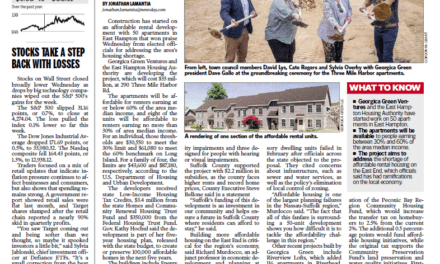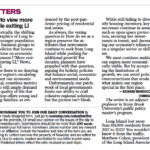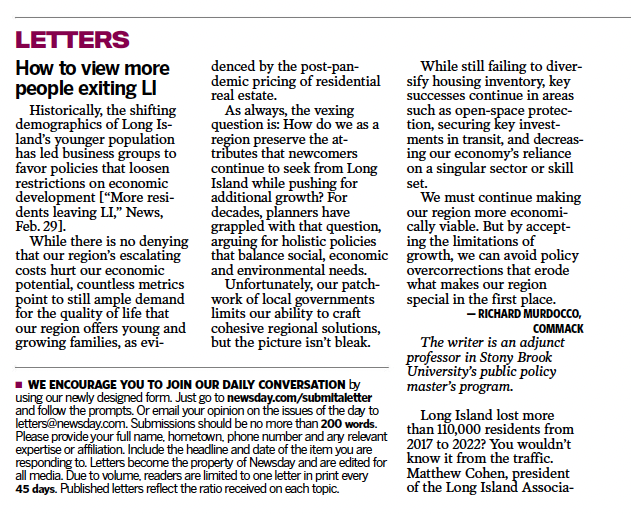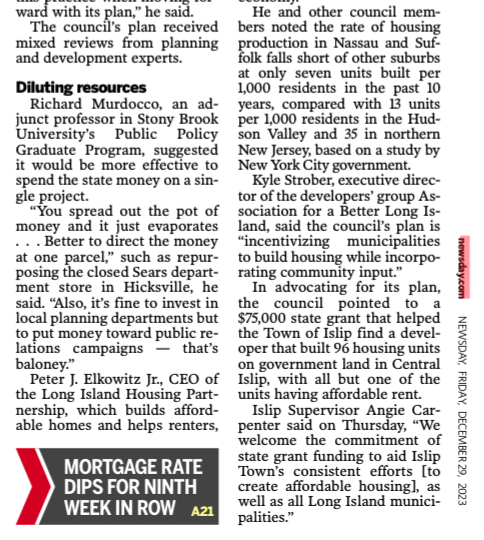It’s all over the news this morning: Long Island’s wealthy areas are experiencing the dreaded brain drain. As reported by David Winzelberg in LIBN:
“Long Island housing advocates and business leaders are calling on the state’s attorney general’s office to enforce affordable housing laws here, in the wake of a new brain-drain study that shows some area communities have lost more than half of their 25- to 34-year-olds since 2000.”
The report, entitled “Richest Communities on Long Island and in Westchester Experiencing Demographic Collapse of Young Adult Workforce,” was written by Alexander Roberts, the executive director of Community Housing Innovations, Inc., a housing advocacy group based in Westchester. The main argument Roberts makes is that “the greatest population losses of 25-34 year olds since 2000 are in the least diverse communities with the most expensive housing, which happen also to be those that have almost no affordable multifamily housing.”
These policy reports from well-meaning groups need to stop, and the media needs to stop feeding into their hype. Long-lasting land use recommendations that are based upon sound data and detailed demographic studies should be dictating our regional conversation, not housing advocates with something to gain by reporting on quick demographic snapshots.
Affordable housing is a hot button issue that I’ve written about on multiple occasions. It is an issue that as a lifelong Long Islander and young professional, I am passionate about. Reports like this fly in the face of sound planning principles thanks to their creation of spurious conclusions, and lead to a flawed approach to tackling our complex and serious affordable housing problem.
Exclusive For A Reason
The exodus of young professionals from Long Island’s wealthy enclaves makes sense. What doesn’t make sense is the report’s linkage to the creation of affordable housing to keep these young adults in those areas. The report highlights areas such as Kings Point, Westhampton, Lloyd Harbor as having alarming rates of brain drain exodus and claims that if more viable housing options existed, the young professionals would stay. Doesn’t it make sense that these areas are exclusive for a reason? Shouldn’t young professionals work to gain access to these communities that are some of the most exclusive areas in the western world? Besides, these areas aren’t exactly known for their dynamic scene and young feel. These are some of the wealthiest areas in the world, with five-acre zoning and gated estates. The creation of denser, multifamily units in these areas do not make sense thanks to limited access, and even more limited infrastructure capacity. If density is to be increased, it should be in downtown areas, not along Nassau’s Gold Coast. Policy recommendations need to be realistic enough to implement.
According to the same logic that the report follows, the argument can be made that young adults are leaving these areas because they lack proper access to industrial factories. Let’s open up the zoning (which in many of these areas is purposefully restricted as special groundwater protection areas) to allow for factories and heavy industry. This solution carries roughly the same weight as those made in the report.
With any brain drain issue, the key to remember is that demographics are cyclical. My friend, Jim Russell, is a geographer who studies the relationship between migration and economic development. He writes for Pacific Standard Magazine, New Geography and elsewhere on the topic almost daily, and argues for what he calls is “the classic brain drain boondoggle.” Jim states:
“Brain drain” might be a real estate developer’s favorite term. Tell the local planning and zoning commission that your cool project will keep young adults close to home. Then trot out the doom and gloom demographics. Long Island is dying. The kids are fleeing because the downtown isn’t fun. Surprise! It’s the birth rate, stupid.
As a planner, it’s frustrating to see the same flawed arguments (in this case, young adults are leaving, we have to plug the hole with density) made in a variety of different flavors.
It’s the Birth Rate
The bottom line is, as birth rates dip, so do certain age demographics. In statistics, correlation (i.e. the exodus of young professionals) is not always the result of causation (i.e. the lack of dense multifamily units in these areas).
For a person in their 20s, Lloyd Harbor will never be as attractive as say, Astoria, Queens or downtown Patchogue. When these fleeing 20-year-olds turn 40, have two kids and a mortgage, areas like Brookville (if they can afford the area) will be a more palatable option thanks to the excellent schools, mansions and Bentley in the driveway.
The report closes with the following words:
“It is ironic that suburban communities that fought so hard to restrict development of affordable and multifamily housing may now be losing 25-34 year olds on an accelerating basis to diverse, urban areas.”
…and goes on to say:
“While it may be difficult to overcome preferences for the urban lifestyle millennials, development of vibrant downtowns, acceptance of diversity and affordable housing appear critical for Long Island and Westchester to remain competitive for the young adult workforce.”
Let’s stop taking the easy way out when dealing with our perceived brain drain by throwing density and multifamily at the issue. Urban solutions don’t always work in a suburban environment. Instead, let’s work to create a cohesive approach to nurturing more diverse housing and employment options in the region.











